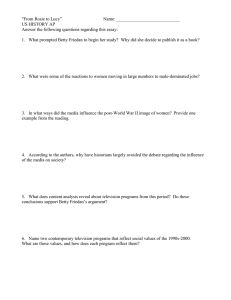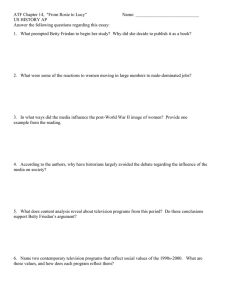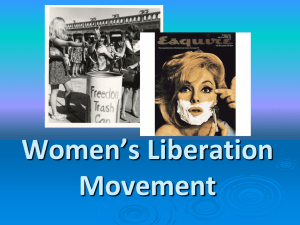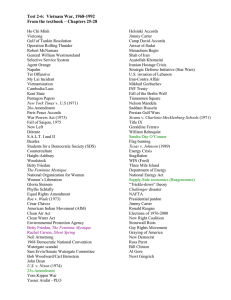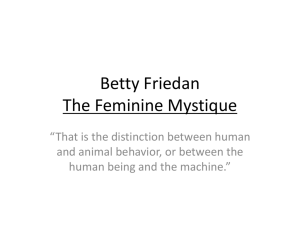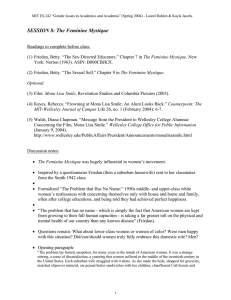From The Feminine Mystique Name: __________________________________ Betty Friedan
advertisement
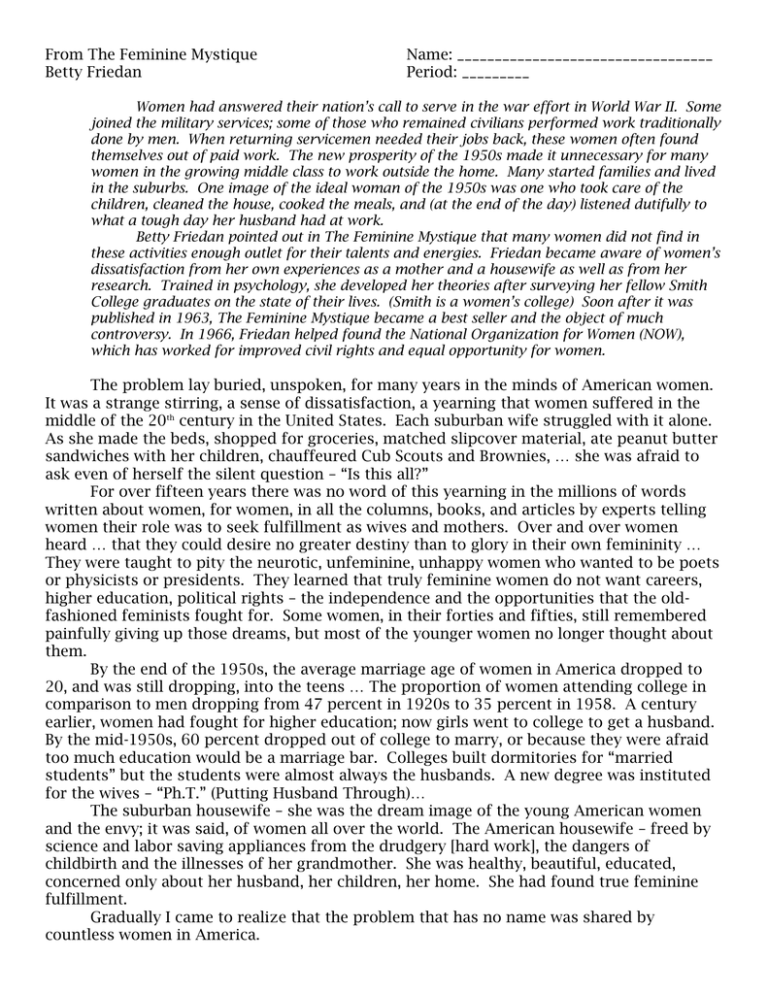
From The Feminine Mystique Betty Friedan Name: __________________________________ Period: _________ Women had answered their nation’s call to serve in the war effort in World War II. Some joined the military services; some of those who remained civilians performed work traditionally done by men. When returning servicemen needed their jobs back, these women often found themselves out of paid work. The new prosperity of the 1950s made it unnecessary for many women in the growing middle class to work outside the home. Many started families and lived in the suburbs. One image of the ideal woman of the 1950s was one who took care of the children, cleaned the house, cooked the meals, and (at the end of the day) listened dutifully to what a tough day her husband had at work. Betty Friedan pointed out in The Feminine Mystique that many women did not find in these activities enough outlet for their talents and energies. Friedan became aware of women’s dissatisfaction from her own experiences as a mother and a housewife as well as from her research. Trained in psychology, she developed her theories after surveying her fellow Smith College graduates on the state of their lives. (Smith is a women’s college) Soon after it was published in 1963, The Feminine Mystique became a best seller and the object of much controversy. In 1966, Friedan helped found the National Organization for Women (NOW), which has worked for improved civil rights and equal opportunity for women. The problem lay buried, unspoken, for many years in the minds of American women. It was a strange stirring, a sense of dissatisfaction, a yearning that women suffered in the middle of the 20th century in the United States. Each suburban wife struggled with it alone. As she made the beds, shopped for groceries, matched slipcover material, ate peanut butter sandwiches with her children, chauffeured Cub Scouts and Brownies, … she was afraid to ask even of herself the silent question – “Is this all?” For over fifteen years there was no word of this yearning in the millions of words written about women, for women, in all the columns, books, and articles by experts telling women their role was to seek fulfillment as wives and mothers. Over and over women heard … that they could desire no greater destiny than to glory in their own femininity … They were taught to pity the neurotic, unfeminine, unhappy women who wanted to be poets or physicists or presidents. They learned that truly feminine women do not want careers, higher education, political rights – the independence and the opportunities that the oldfashioned feminists fought for. Some women, in their forties and fifties, still remembered painfully giving up those dreams, but most of the younger women no longer thought about them. By the end of the 1950s, the average marriage age of women in America dropped to 20, and was still dropping, into the teens … The proportion of women attending college in comparison to men dropping from 47 percent in 1920s to 35 percent in 1958. A century earlier, women had fought for higher education; now girls went to college to get a husband. By the mid-1950s, 60 percent dropped out of college to marry, or because they were afraid too much education would be a marriage bar. Colleges built dormitories for “married students” but the students were almost always the husbands. A new degree was instituted for the wives – “Ph.T.” (Putting Husband Through)… The suburban housewife – she was the dream image of the young American women and the envy; it was said, of women all over the world. The American housewife – freed by science and labor saving appliances from the drudgery [hard work], the dangers of childbirth and the illnesses of her grandmother. She was healthy, beautiful, educated, concerned only about her husband, her children, her home. She had found true feminine fulfillment. Gradually I came to realize that the problem that has no name was shared by countless women in America. It is no longer possible to ignore that voice, to dismiss the desperation of so many American women. This is not what being a woman means, no matter what the experts say … [P]art of the strange newness of the problem is that it cannot be understood in terms of the age-old material problems of man: poverty, sickness, hunger, cold. The women who suffer this problem have a hunger that food cannot fill. It persists in women who husbands are struggling interns and law clerks, or prosperous doctors and lawyers; in wives of workers and executives who make $5,000 a year or $50,000… It is no longer possible today… to say that education and independence and equality with men have made American women unfeminine…Women who suffer this problem…have lived their whole lives in the pursuit of feminine fulfillment. They are not career women (although career women may have other problems); they are women whose greatest ambition has been marriage and children. Review Questions 1. During the 1950s, what was the expected role of married middle class women? 2. What was the general attitude in the 1950s toward those women who wished to have careers? 3. (a) What did Betty Friedan mean when she referred to the PhT degree? (b) why was she critical of the “degree”? 4. What was the “problem that had no name”? 5. How do you think Friedan would feel about the roles of women today? Does this chart support or refute Friedan’s argument? Did Friedan’s book have any impact on the chart? What do these media based images portray about women in the 1950s? What would Friedan have argued about the impact of mass media?
